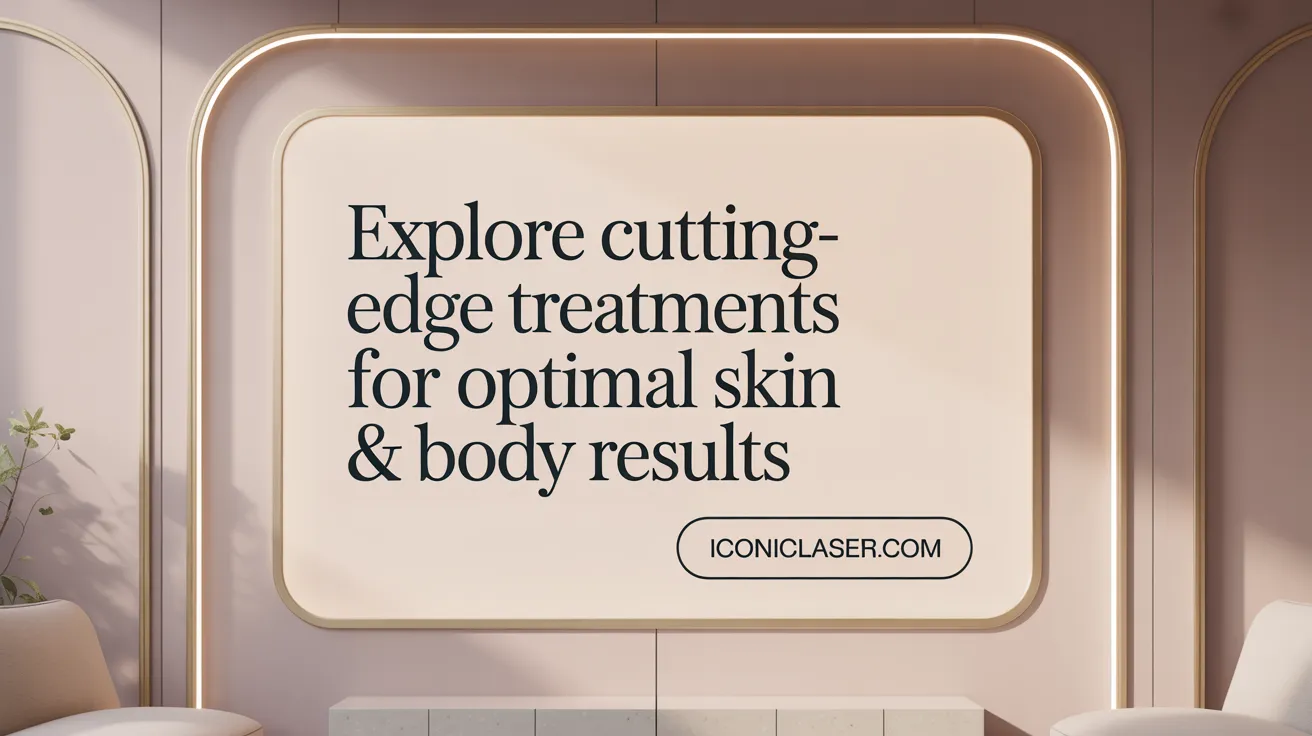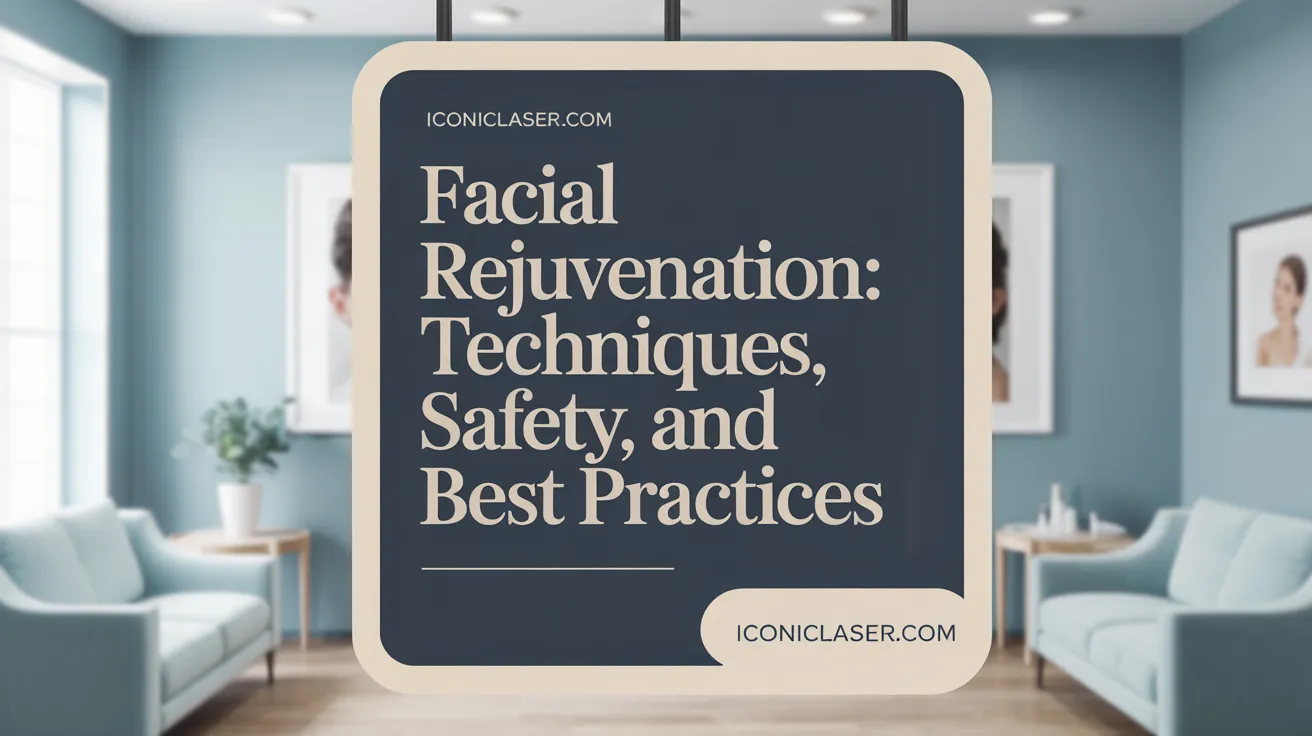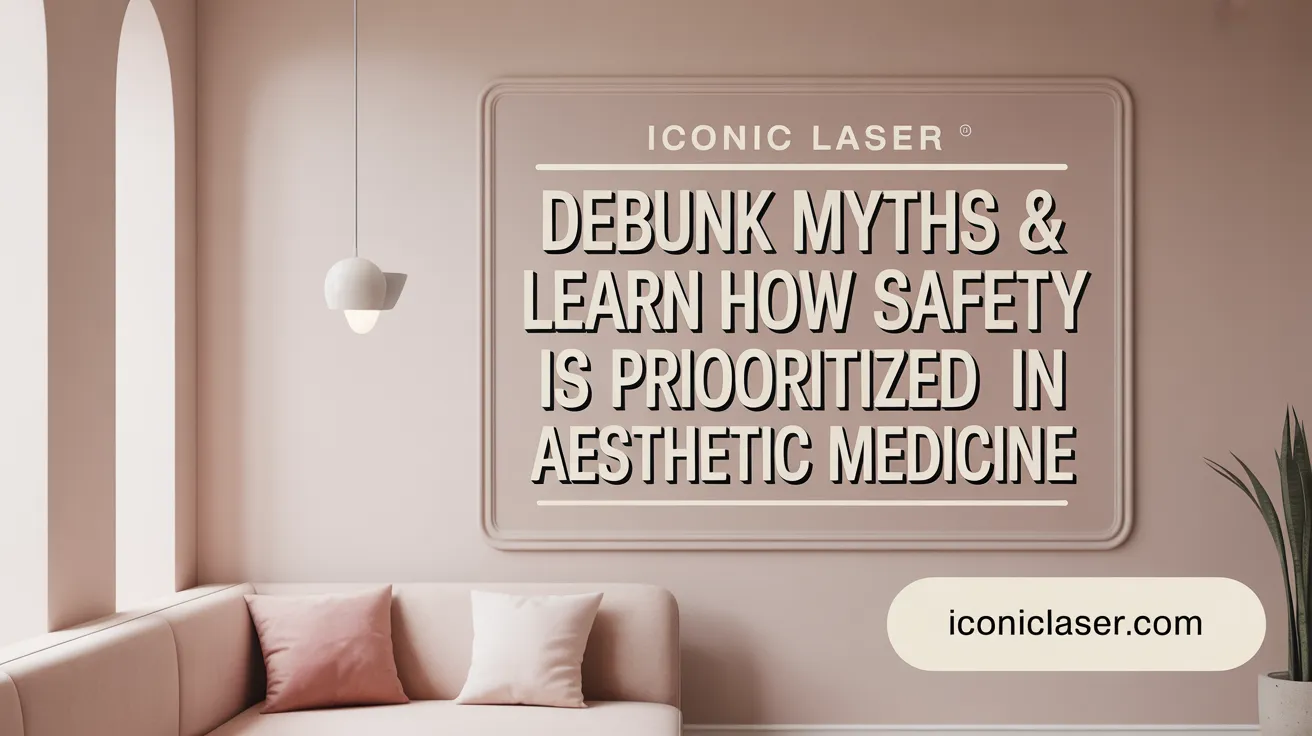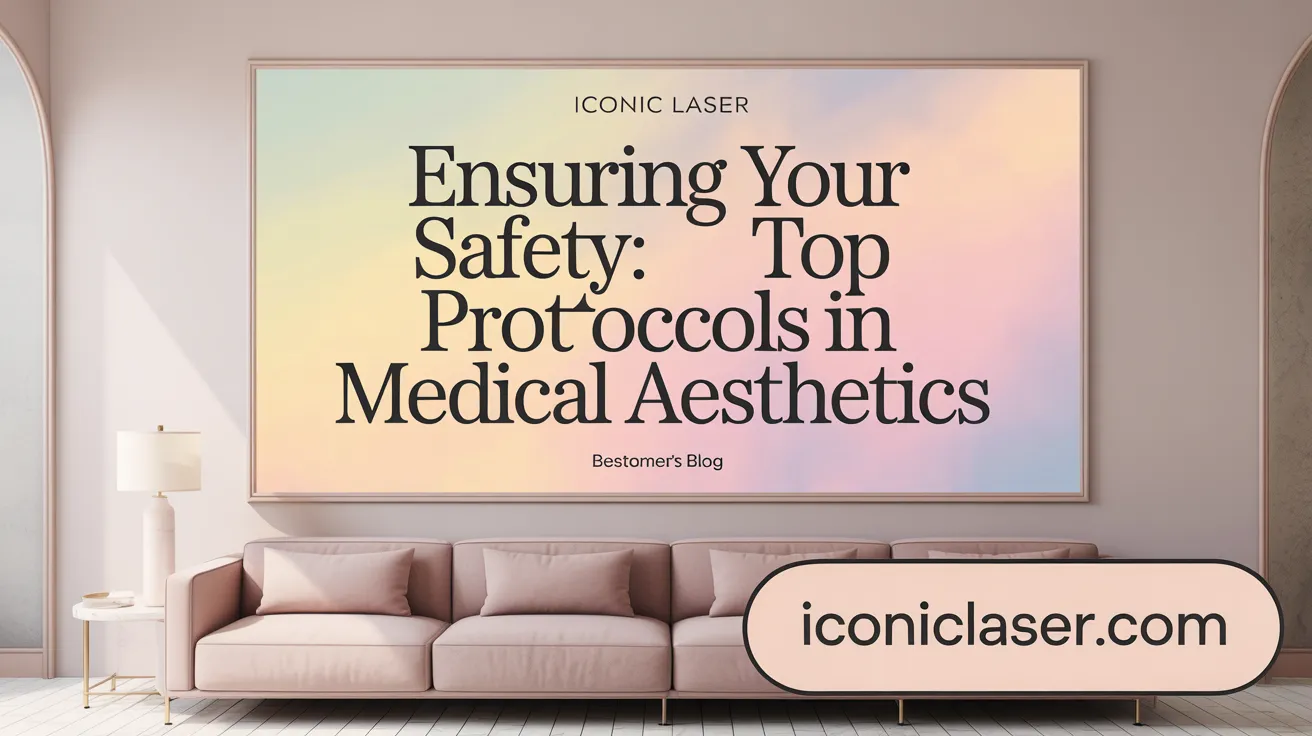An Overview of Safety and Myths in Medical Aesthetics
Importance of Patient Safety
Patient safety is the cornerstone of medical aesthetics, ensuring not only effective results but also fostering patient trust and clinic reputation. Professional medical spas operate under strict medical supervision, with licensed and trained practitioners following thorough patient screening, hygiene protocols, and detailed informed consent processes. Continuous staff education, comprehensive SOPs, and rigorous infection control practices are implemented to minimize risks such as infections or complications from injectables. Compliance with local and federal regulations, alongside ongoing audits and incident reporting, maintains high safety standards crucial for patient wellbeing.
Common Misconceptions in Medical Aesthetics
Medical aesthetics is often misunderstood as solely vanity-driven. However, it supports personal wellbeing and self-care, with procedures addressing both cosmetic and medical needs. Contrary to myths, Botox—a widely used treatment—is FDA-approved, safe, and effective for multiple conditions beyond wrinkle reduction, including migraines and excessive sweating. Another misconception is about emerging treatments; for instance, skin resurfacing solutions like Morpheus8 are safe for all skin types without heightened risks of hyperpigmentation.
Scope of Treatments Offered by Premium Clinics
Top-tier aesthetic clinics provide a broad range of scientifically backed, non-invasive treatments. These include injectables like Botox and dermal fillers, advanced device-based therapies such as CoolSculpting® Elite for fat reduction, and innovative skin treatments including red light therapy for skin rejuvenation. Clinics also emphasize personalized care through thorough consultations, ensuring treatments are suited to individual health profiles and aesthetic goals. This comprehensive approach, combined with strict safety protocols, defines professional medical aesthetic services in today's market.
Advanced Dermatological and Cosmetic Treatments Offered

What types of advanced dermatological and cosmetic treatments are offered by a premium medical aesthetic clinic?
A premium medical aesthetic clinic in Troy, Michigan, provides a wide array of advanced dermatological and cosmetic treatments designed to meet diverse patient needs.
Skin rejuvenation procedures
These include laser skin resurfacing, chemical peels, and microneedling techniques such as Morpheus8 microneedling and Morpheus8 and hyperpigmentation. These treatments stimulate collagen production, improve skin texture, reduce wrinkles and scars, and address pigmentation concerns without significant downtime.
Facial enhancement techniques
Clinics utilize Botox Treatment in Troy, Michigan to soften fine lines and wrinkles safely, often for cosmetic and medical conditions like Botox for Migraines and Botox for Excessive Sweating. Dermal fillers offer volume restoration and contouring, while non-surgical facelifts provide subtle, natural-looking rejuvenation without invasive surgery.
Body contouring options
Non-invasive fat reduction technologies, such as CoolSculpting safety information, are popular. This FDA-cleared procedure freezes fat cells with a strong safety profile and rare side effects like paradoxical adipose hyperplasia (PAH). Additional options include radiofrequency and ultrasound therapies, which help tighten skin and enhance body contours.
Women’s wellness services
Specialized offerings such as hormone therapy and skin health optimization focus on enhancing overall wellness alongside aesthetic improvements. These treatments support hormonal balance, mitochondrial health, and youthful skin appearance, often integrated within holistic anti-aging strategies.
This comprehensive approach ensures personalized care, prioritizing safety and efficacy through Medical Aesthetics Compliance Tips and adherence to updated Patient Safety in Aesthetic Procedures protocols.
Understanding Skin Rejuvenation: Procedures and Safety Protocols

What are the common procedures involved in skin rejuvenation at a medical aesthetic clinic?
Skin rejuvenation encompasses various non-invasive and surgical options to enhance skin texture, tone, and facial aesthetics. Commonly offered procedures include:
- Chemical Peels: These treatments exfoliate the skin's surface, addressing discoloration, fine lines, and rough patches.
- Laser Therapy: Advanced lasers stimulate collagen production, reduce pigmentation, and improve skin elasticity. For more on safety standards and regulations, see Medical Aesthetics Compliance Tips.
- Microdermabrasion and Microneedling: These mechanical techniques promote skin renewal and reduce scars and wrinkles.
- Dermal Fillers and Fat Grafting: Used for restoring volume loss, smoothing wrinkles, and contouring facial features. Learn more about Aseptic technique in aesthetic procedures and Patient Safety in Aesthetic Procedures.
- Surgical Procedures: Eyelid surgery, brow lifts, and neck lifts provide more pronounced and lasting improvements. For expertise in outpatient plastic surgery, visit Dr. Samuel Mucci.
What does post-treatment care involve?
Proper post-treatment care is pivotal to sustain rejuvenation results and minimize complications. Essential recommendations include:
- Avoiding sun exposure and applying broad-spectrum sunscreen diligently.
- Following specific skincare regimens advised by clinicians to aid healing.
- Avoiding cosmetics for a prescribed period post-procedure, especially after injections or laser treatments. For detailed information on red light therapy and its benefits for skin healing, refer to Red light therapy benefits.
How do medical aesthetic clinics ensure safety during skin treatments?
Safety is a cornerstone in aesthetic medicine, achieved through comprehensive protocols such as:
- Patient Screening: Detailed medical history review to identify contraindications and tailor treatment plans. Insights available at Patient safety in medical spas.
- Informed Consent: Clear explanation of procedures, risks, and expectations to ensure patient understanding. More on Informed consent in medical spas.
- Aseptic Technique: Meticulous hygiene practices during procedures to prevent infections. See Aseptic technique in aesthetic procedures.
- Ongoing Staff Training: Regular education and competency assessments maintain high care standards. Related information at Continuous staff education.
- Clinical Audits and Compliance: Routine practice evaluations ensure adherence to regulations and safety guidelines. Additional guidance at Medical Aesthetics Compliance Tips.
These measures, coupled with individual treatment planning, help maximize outcomes while minimizing risks in skin rejuvenation procedures.
Facial Enhancement Treatments: Mechanisms and Best Practices

How do facial enhancement treatments work in a medical aesthetic clinic?
Facial enhancement treatments commonly combine injectables and non-invasive methods to rejuvenate and contour the face effectively. Injectable products such as Botox Treatment in Troy, Michigan block nerve signals to relax muscles, reducing wrinkle appearance. Dermal fillers restore lost volume and smooth out fine lines. Techniques like fat transfer also replenish facial fullness. Non-invasive procedures, including microneedling, laser therapies, and chemical peels, stimulate collagen production and improve skin texture.
What are the injectable and non-invasive techniques used?
- Injectables: Botox Treatment in Troy, Michigan reduces muscle contractions temporarily; dermal fillers like hyaluronic acid variants add volume; fat transfer uses a patient's own fat for natural enhancement.
- Non-invasive: Morpheus8 microneedling safely disrupts the skin to promote regeneration; laser treatments target pigmentation and elasticity; chemical peels remove damaged surface layers for smoother skin.
- Advanced options: CoolSculpting safety information and Kybella offer fat reduction without surgery, reshaping facial features subtly.
Why is anatomical knowledge important for patient safety?
Understanding facial anatomy is critical to reducing risks such as Vascular Occlusions in Facial Injections, infections, and unintended aesthetic outcomes. Practitioners must be trained extensively in facial structures to administer treatments precisely. Proper screening, hygiene, and complication management rely on this expertise. Continuing education and adherence to Aseptic Technique in Aesthetic Procedures further enhance safety profiles.
Together, these approaches provide comprehensive facial enhancement treatments that are both effective and safe when delivered by qualified professionals.
Body Contouring Innovations and Patient Safety
What body contouring options are typically available at advanced aesthetic clinics?
Advanced aesthetic clinics offer a broad range of body contouring treatments catering to diverse patient needs. Non-invasive options like CoolSculpting® Elite FDA approval use controlled cooling (cryolipolysis) to selectively target and reduce fat deposits without surgery. Other popular modalities include radiofrequency and laser lipolysis that leverage heat to dissolve fat cells and firm the skin.
For patients desiring more immediate results, surgical options such as liposuction remain a reliable choice, enabling precise sculpting and contouring. Many clinics create customized protocols combining non-invasive and surgical methods to optimize outcomes while maintaining natural aesthetics.
What is the safety profile of CoolSculpting and similar treatments?
CoolSculpting has been FDA-approved and widely used for over 11 years as a safe, non-invasive fat reduction procedure. Large clinical experience and thousands of supporting studies endorse its efficacy and favorable safety profile. Common side effects are typically mild and transient, including temporary redness, bruising, or numbness.
However, like all medical procedures, CoolSculpting carries rare risks. The most notable is paradoxical adipose hyperplasia (PAH), a condition where treated fat enlarges rather than diminishes, occurring in roughly 0.033% of treatments. Clinics must maintain vigilant post-treatment monitoring and report adverse events to ensure ongoing patient safety and regulatory oversight.
What precautions and rare side effects should patients be aware of?
To minimize risks, clinics adhere to strict patient screening protocols, excluding individuals with contraindications like cold sensitivity disorders or active infections at the treatment site. Comprehensive informed consent procedures clearly outline potential side effects and complications.
Patients should be aware that rare side effects beyond PAH may include temporary swelling, bruising, or discomfort. Medical spas practicing aseptic technique in aesthetic procedures and robust hygiene standards further reduce risks of infection and complications.
Ultimately, choosing a reputable clinic with trained medical staff, thorough pre-procedure evaluation, and transparent communication contributes substantially to safe and satisfying body contouring experiences.
Women’s Wellness Services: Integrating Health with Aesthetic Care
What women's wellness services might a medical aesthetic clinic provide?
Women’s wellness services at medical aesthetic clinics go beyond traditional cosmetic procedures to focus on holistic health and well-being related to hormonal and reproductive changes. These clinics commonly offer treatments like hormonal therapies and vaginal rejuvenation designed to address both aesthetic and functional concerns.
Advanced technologies such as the Morpheus8 microneedling device—an FDA-approved radiofrequency microneedling system—are employed for vaginal rejuvenation. This treatment improves tissue firmness and stimulates collagen production, helping to restore vaginal health and elasticity. EmpowerRF is another cutting-edge device used to improve pelvic floor function, helping manage urinary incontinence and promoting overall pelvic wellness.
These wellness treatments also target skin issues related to hormonal fluctuations, such as dryness or sun damage common during menopause. By enhancing skin health and addressing intimate concerns, the services foster deeper benefits beyond physical appearance, including increased confidence and improved emotional well-being.
By integrating advanced medical technology with personalized care, these clinics aim to support women across different life stages, empowering them with treatments that nurture both health and beauty. For more insights into related treatments and patient safety, explore our detailed guide on Patient Safety in Aesthetic Procedures and learn about Debunking New Myths In Aesthetics.
Dispelling Common Myths and Upholding Safety in Aesthetic Medicine

What are some common misconceptions about medical aesthetics?
Medical aesthetics is often misunderstood as merely a vanity pursuit exclusively for women. However, it is a form of self-care in aesthetic medicine and personal wellbeing embraced by a diverse clientele, including a growing number of men seeking treatments like Botox and dermal fillers for men. Many are unaware that aesthetic medicine history has ancient origins but has evolved into a scientifically grounded field with strict safety standards and regulatory oversight.
How does FDA approval and regulation enhance safety?
Products such as Botox and CoolSculpting® Elite FDA approval have undergone rigorous FDA evaluations to confirm their safety and effectiveness. For example, CoolSculpting safety information, with over a decade of use, has rare side effects documented and managed transparently by clinicians. Such regulatory reviews ensure that treatments offered meet high safety benchmarks, instilling confidence in patients.
Why is medical supervision and proper training critical?
Aesthetic procedures require professional oversight by licensed medical practitioners to safeguard patient health. Clinics operate under medical directors who verify qualifications and enforce protocols covering patient screening, informed consent, aseptic techniques, and complication management. Continuous education—including practical skill assessments and peer reviews—maintains competence and keeps staff updated on best practices as emphasized in Med spa supervision by physicians.
Patient safety is further reinforced by detailed procedural standards, hygiene measures equivalent to hospital settings, and transparent communication educating patients about realistic outcomes and risks, aligning with principles of Patient safety in medical spas and Patient Safety in Aesthetic Procedures. This multifaceted approach ensures that aesthetic medicine delivers transformative results while prioritizing the wellbeing of every individual.
| Topic | Key Points | Details |
|---|---|---|
| Myths about Medical Aesthetics | Vanity-only, women-exclusive | Actually supports self-care; men are growing consumers |
| FDA Approvals and Regulation | Rigorous product evaluation | Enhances safety, ensures efficacy, transparent rare side effects |
| Medical Supervision and Training | Licensed oversight, continuous education, protocols | Prevents complications, maintains hygiene, reinforces informed consent |
Protocols and Practices Ensuring Patient Safety in Medical Aesthetics

How do medical aesthetic clinics ensure patient safety?
Medical aesthetic clinics prioritize patient safety in medical spas through a comprehensive approach that encompasses several critical protocols and practices.
Infection Control and Aseptic Techniques
Infection prevention is central to safety in aesthetic procedures, particularly those involving skin puncture such as injectable treatments. Clinics adhere to strict aseptic technique in aesthetic procedures including thorough skin cleansing before procedures, use of personal protective equipment (PPE), and careful handling of needles and cannulae. These measures minimize contamination and reduce complications such as infections, inflammatory reactions, and vascular occlusions. Post-procedure, protocols include avoiding cosmetics for 24 hours and maintaining rigorous clinic surface and waste disinfection standards. Additional safeguards during events like the COVID-19 pandemic include patient screening and social distancing.
Patient Consultation and Screening
Prior to any treatment, detailed patient consultations assess medical history, allergies, and contraindications. This screening process helps identify risks and tailor treatments appropriately. Medical oversight for patient safety by licensed practitioners ensures that only safe and suitable procedures are performed. Comprehensive Standard Operating Procedures (SOPs) in medical spas support consistent safety practices across consultations, treatments, and post-care phases.
Informed Consent and Documentation
Clinics provide clear and transparent informed consent in medical spas forms that thoroughly explain treatment procedures, potential risks, and expected outcomes to patients. This process promotes patient understanding and trust. Detailed documentation of patient encounters, medical histories, and treatment outcomes aids in quality assurance and legal compliance. Facilities maintain confidential incident reporting systems and conduct root-cause analysis in healthcare to prevent future adverse events.
Importance of Ongoing Education and Compliance
Continuous education through workshops, certification programs for spa staff, and skill assessments ensures practitioners stay current with safety standards and evolving techniques. Regular audits and adherence to regulations for medical spas maintain legal compliance and uphold clinical hygiene standards equivalent to hospital settings. By fostering a culture of safety, medical aesthetic clinics in Troy, Michigan, and beyond build trust while achieving operational excellence in medical spas.
Building Confidence Through Knowledge and Safety Commitment
Choosing Reputable Clinics
Selecting a medical spa or aesthetic clinic with stringent medical oversight and qualified professionals is essential for patient safety. Reputable clinics operate under the supervision of licensed medical directors and employ board-certified injectors trained in aesthetic medicine. These facilities maintain high standards of clinical hygiene, thorough patient screening, and robust informed consent processes to minimize risks and ensure personalized care.
The Value of Informed Patients
Patient education is a cornerstone of safety and trust. Clinics prioritize clear communication about procedures, potential risks, and expected outcomes, enabling patients to make well-informed decisions. Involved patients who understand their treatments and safety protocols are better positioned to participate actively in their care and promptly report any concerns.
Advancements in Safety Practices
The field of medical aesthetics continually evolves with updated safety protocols to address emerging challenges. Continuous staff education, including workshops and certification programs, maintain high competence levels. Infection control standards have been enhanced, especially for injectable procedures, with strict aseptic techniques and post-treatment care guidelines. Additionally, regulatory oversight ensures up-to-date safety messaging and device approvals, underscoring an ongoing commitment to patient well-being in clinics.
Collectively, these elements foster a confident patient experience grounded in knowledge and safety.
